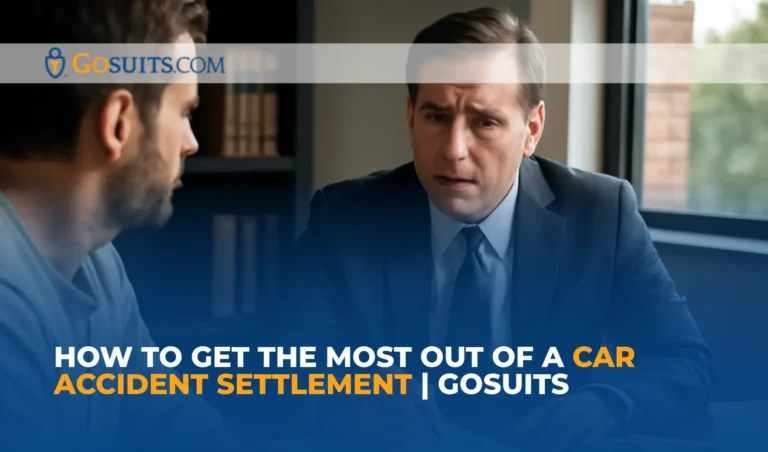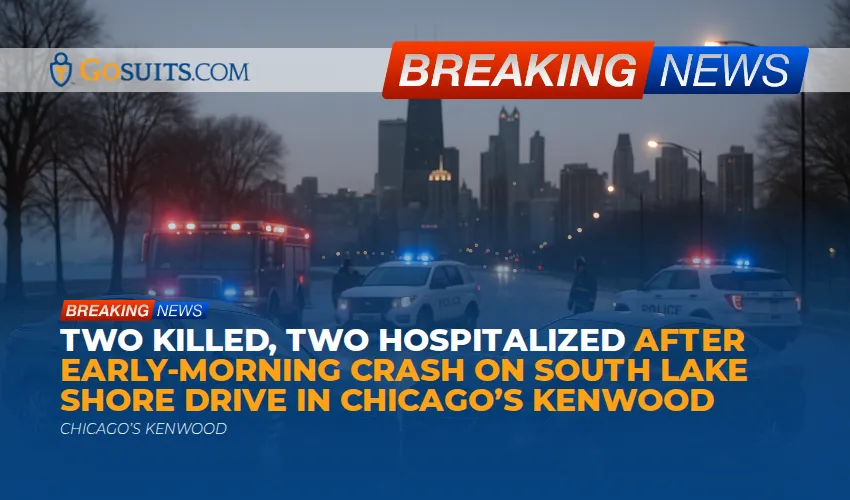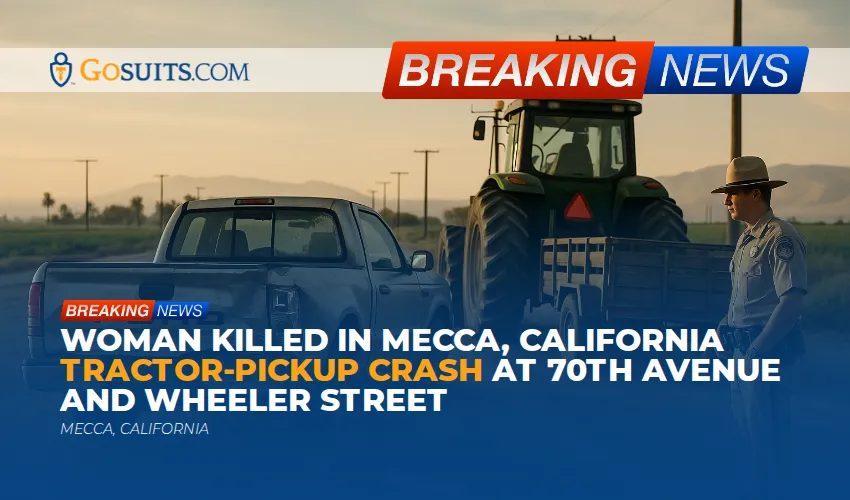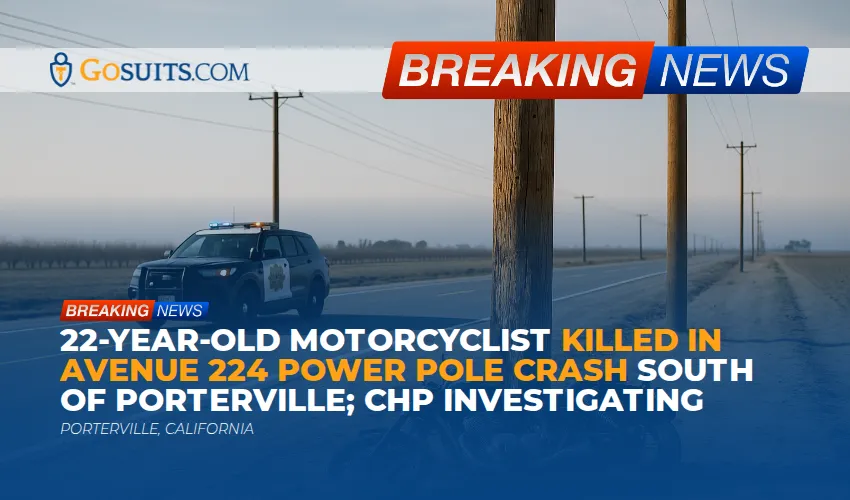- What is a car accident settlement and how does it work in TX, CA, and IL?
- How do you preserve evidence after a crash to maximize your car accident settlement?
- What medical documentation strengthens a car accident claim?
- How do insurance claim processes and adjuster tactics affect your settlement?
- What is the statute of limitations for car accident claims in Texas, California, and Illinois?
- How does comparative negligence impact pain and suffering and other damages?
- How do you calculate lost wages and future earnings in a settlement?
- What is a demand letter and what should it include?
- Should you give a recorded statement or sign medical releases requested by an insurer?
- What damages can you claim for property damage and rental in TX, CA, and IL?
- How do liens and subrogation affect your net recovery?
- When should you file a lawsuit and what happens after filing?
- How are settlements paid and what does a release mean?
- How do uninsured and underinsured motorist claims work in these states?
- What if your claim is denied or the offer is unfair?
- How do you use police reports and crash data to support your case?
- What local factors in Houston, Dallas, Austin, San Antonio, Los Angeles, San Diego, San Francisco, Chicago, Cook County, Harris County, and Orange County should you know?
- How can a personal injury lawyer help maximize your car accident settlement?
- How does GoSuits approach car accident cases and client service?
- Where can you find the sources cited in this guide?
What is a car accident settlement and how does it work in TX, CA, and IL?
A car accident settlement is a civil agreement to resolve injury and property damage claims without a trial. You, the injured person, accept a payment from the at-fault driver’s insurer or your own insurer in exchange for signing a release of claims. Settlements can cover medical bills, lost wages, pain and suffering, vehicle repair or total loss, and out-of-pocket costs. Each state’s laws on fault, deadlines, and insurance influence the path to settlement.
Across Texas, California, and Illinois, the process generally includes:
- Claim set-up: Notifying the liable insurer and your own insurer. In Texas and Illinois, most claims are handled under fault-based liability systems. California is also fault-based. No-fault rules do not apply in these states for standard auto policies.
- Treatment and documentation: Getting timely medical care, preserving bills and records, documenting lost wages, and gathering proof of liability and damages.
- Negotiation: Sending a demand letter with supporting evidence to negotiate with the adjuster. If the offer is insufficient, litigation may be filed.
- Resolution: Settlement payment disbursed, liens resolved, and a release signed.
Nationally, traffic safety data highlights the stakes. The National Highway Traffic Safety Administration reported an estimated 40,990 traffic fatalities in 2023, a 3.6 percent decrease from 2022’s 42,514 deaths, but still far too high (NHTSA). Crash deaths also carry significant economic costs. The Centers for Disease Control and Prevention has reported tens of billions of dollars in medical and work loss costs from crash deaths each year (CDC). These impacts underline why careful documentation and strategic negotiation matter.
How do you preserve evidence after a crash to maximize your car accident settlement?
What you do in the hours and days after a collision can shape the entire claim. Courts apply rules about preserving evidence, and insurers evaluate credibility based on documentation.
- Call police and obtain a report: Request an officer at the scene when safe, especially in Houston, Dallas, Austin, San Antonio, Los Angeles, San Diego, San Francisco, Chicago, and surrounding counties. Formal crash reports carry weight in settlement talks.
- Photograph and video everything: Vehicles, skid marks, debris, traffic signals, road conditions, and visible injuries. Save original date-stamped files.
- Identify witnesses: Names, contact details, and brief written statements when possible.
- Secure vehicle and property: Keep the damaged vehicle available for inspection before repairs. If repair is unavoidable, retain parts and obtain detailed appraisals.
- Preserve digital data: Download dashcam footage immediately. Ask your lawyer about sending preservation letters to businesses for surveillance footage. Modern cars often store event data; preserving this may require prompt action.
- Keep a symptom diary: Daily notes on pain, limitations, missed events, and sleep disruptions help corroborate non-economic damages.
In litigation, courts can sanction parties for destroying relevant evidence. Federal courts address preservation and sanctions in the Federal Rules of Civil Procedure, including rules on disclosures, discovery, and sanctions (USCourts.gov). Even before filing, acting promptly to preserve evidence supports your credibility and can help maximize a car accident settlement.
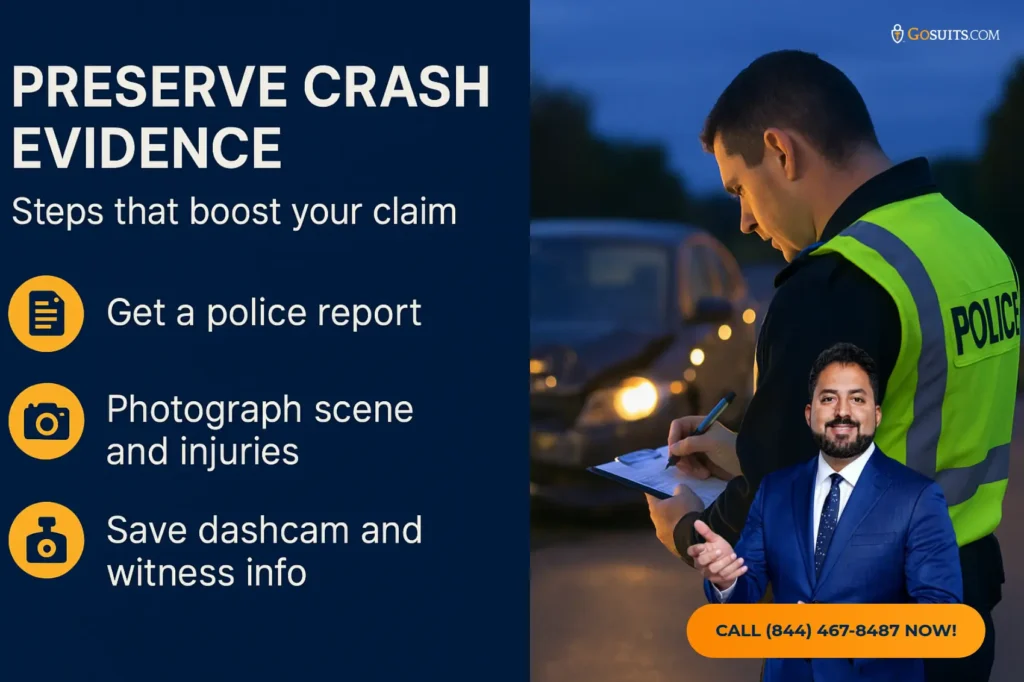
What medical documentation strengthens a car accident claim?
Medical proof is the foundation of injury claims. Gaps or missing records often lead to smaller offers.
- Emergency evaluation: Visit an ER, urgent care, or your primary provider as soon as symptoms emerge, even if delayed.
- Complete records: Obtain diagnostic imaging, physician notes, therapy notes, and surgical reports. Under federal law, you have a right to access your medical records and billing data (HHS HIPAA Right of Access).
- Consistent treatment: Follow prescribed plans. Document reasons for any missed appointments.
- Itemized bills and coding: Keep CPT-coded statements and EOBs. These help evaluate past medical expenses and address insurer challenges.
- Future care: If injuries are ongoing, request physician opinions on future treatment and costs supported by records.
- Pain documentation: California’s civil jury instructions recognize non-economic damages like pain, suffering, and loss of enjoyment, without a set formula, relying on evidence and juror judgment (Judicial Council of California, CACI 3905A).
How do insurance claim processes and adjuster tactics affect your settlement?
Understanding the rules that govern insurers can help you respond confidently.
- Texas claim handling timelines: The Prompt Payment of Claims Act sets deadlines for acknowledgment, investigation, and payment, with potential interest penalties for late payment (Tex. Ins. Code ch. 542; Texas Department of Insurance).
- California fair claims practices: Regulations require prompt and fair claim handling by insurers, including timelines for acceptance or denial and communications with claimants (California Department of Insurance).
- Illinois unfair claims practices: State law prohibits misrepresentations and unfair settlement tactics, and outlines standards for reasonable investigations and prompt communications (215 ILCS 5/154.6).
Common adjuster tactics include early low offers before your treatment completes, broad medical authorizations, or recorded statements that can be used to dispute liability or causation. You can request a reasonable time to gather records and may decline broad medical releases not narrowly related to your injuries. If you are represented, direct communications go through your attorney.
What is the statute of limitations for car accident claims in Texas, California, and Illinois?
Deadlines are critical. Missing them can bar your civil claim entirely.
- Texas: Two years from the date of injury for personal injury and property damage in most cases (Tex. Civ. Prac. & Rem. Code § 16.003). Tolling can apply for minors and those of unsound mind (§ 16.001).
- California: Two years for personal injury claims arising from car crashes (Cal. Code Civ. Proc. § 335.1). Tolling may apply for minors and other limited circumstances (CCP § 352).
- Illinois: Two years for personal injury (735 ILCS 5/13-202) and generally five years for property damage (735 ILCS 5/13-205). Tolling rules for minors and others may apply (735 ILCS 5/13-211).
Claims against government entities can have shorter administrative claim deadlines. Do not wait to evaluate time limits for Houston, Dallas, Austin, San Antonio, Los Angeles, San Diego, San Francisco, Chicago, and their surrounding counties.
How does comparative negligence impact pain and suffering and other damages?
Comparative negligence reduces your recovery by your percentage of fault. State rules differ.
- Texas: Modified comparative responsibility. You recover only if you are not more than 50 percent at fault. Damages are reduced by your percentage (Tex. Civ. Prac. & Rem. Code ch. 33).
- California: Pure comparative negligence. You can recover even if you are 99 percent at fault, but your recovery is reduced accordingly. The California Supreme Court adopted this rule in Li v. Yellow Cab Co., 13 Cal. 3d 804 (1975) (CourtListener).
- Illinois: Modified comparative negligence with a 51 percent bar. You cannot recover if more than 50 percent at fault, and damages are reduced for lesser percentages (735 ILCS 5/2-1116).
Comparative fault applies to both economic damages and non-economic damages, including pain and suffering. Adjusters use comparative fault arguments to discount offers. Solid liability proof is key to maximizing a car accident settlement in TX, CA, and IL.
How do you calculate lost wages and future earnings in a settlement?
Lost income claims must be supported by documentation and, in significant cases, expert analysis.
- Past wages: Gather pay stubs, W-2s, and employer verification of missed time and job duties. The IRS provides guidance on wage reporting forms like W-2s that help establish lost income (IRS).
- Self-employed income: Use tax returns, 1099s, profit and loss statements, and client contracts to show pre- and post-crash earnings.
- Sick leave and PTO: Track any used benefits because you can claim their value.
- Future earnings and capacity: For lasting injuries, medical opinions on restrictions, vocational assessments, and economic analyses can quantify future losses.
Each state allows recovery of reasonable economic losses tied to the crash. Precision and credible records can meaningfully impact settlement valuation.
What is a demand letter and what should it include?
A demand letter is a structured settlement proposal with supporting proof. It frames your case and anchors negotiations.
- Liability narrative: A clear, fact-based explanation linked to evidence like the police report, photos, and witness statements.
- Medical summary: Timeline of treatment with key diagnostic findings, physician opinions on causation, and future care needs.
- Damages calculation: Itemized medical bills, lost wages, property damage, and reasonable non-economic damages supported by symptom logs and impact statements.
- Supporting exhibits: Records, bills, photos, repair estimates, and applicable statutes or jury instruction excerpts when helpful.
- Deadline and next steps: A reasonable timeframe for response consistent with applicable claim-handling rules in Texas, California, or Illinois.
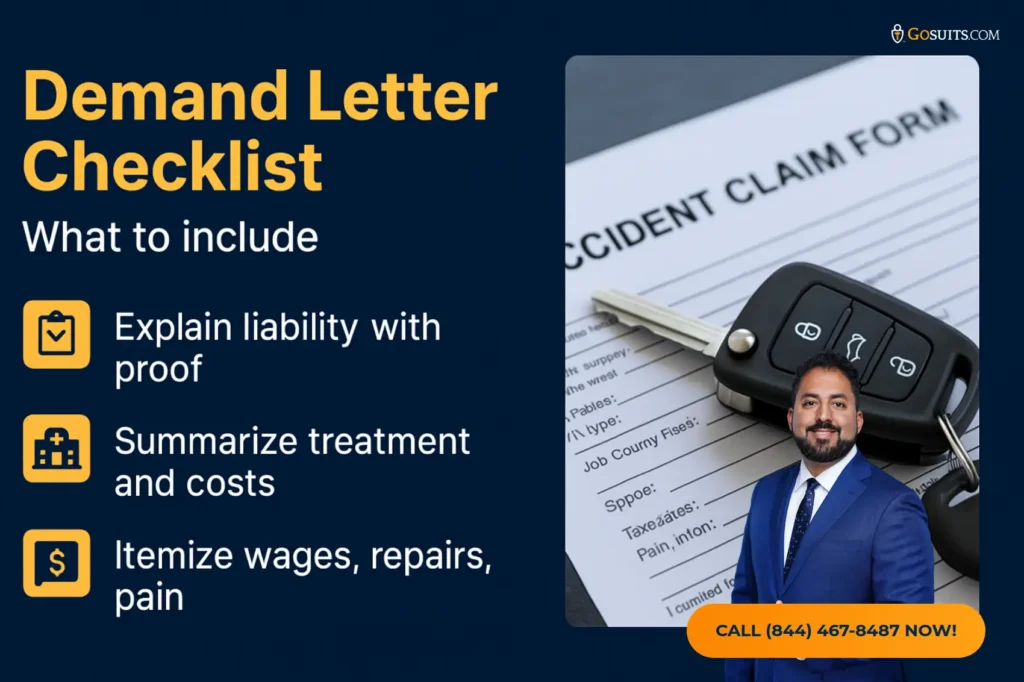
Should you give a recorded statement or sign medical releases requested by an insurer?
Approach insurer requests with care.
- Recorded statements: You generally have a contractual duty to cooperate with your own insurer, which can include a statement. With the other driver’s insurer, you are not usually required to give a recorded statement. Statements can be used to dispute liability or minimize injuries. If you have counsel, requests go through your attorney.
- Medical releases: Broad authorizations can open up irrelevant history. Narrow, time-limited releases focused on crash-related treatment are more appropriate. California, Texas, and Illinois regulators require fair investigations but do not demand unlimited medical access (TDI claim tips; CA DOI; Illinois DOI).
If you are uncertain, speak with a car accident lawyer before giving recorded statements or signing releases.
What damages can you claim for property damage and rental in TX, CA, and IL?
Property claims are often resolved earlier than injury claims, but they affect overall leverage and satisfaction.
- Repair or total loss: You are typically entitled to repair to pre-loss condition or fair market value if totaled. Keep all estimates and invoices. In Texas, consumers have the right to choose the repair shop and are not required to use insurer-recommended facilities (TDI Auto Insurance Consumer Tips).
- Diminished value: Depending on state law and policy language, you may claim post-repair diminished value from the at-fault insurer if supported by evidence.
- Rental and loss of use: Reasonable rental or loss of use damages may be recoverable during repairs or until total loss payment.
- Personal property: Document damaged items in the vehicle with purchase records and photos.
California and Illinois regulators also publish consumer-facing guidance on auto claims that can help you understand rights and timelines (CA DOI Auto Guides; Illinois Auto Insurance).

How do liens and subrogation affect your net recovery?
Liens and subrogation rights can reduce your net settlement if not addressed correctly.
- Texas hospital liens: Hospitals may have a lien on claims for reasonable charges within statutory limits if notice requirements are met (Tex. Prop. Code ch. 55).
- California health care liens: California’s Hospital Lien Act gives hospitals limited lien rights against third-party recoveries with required notices (Cal. Civ. Code § 3045.1 et seq.).
- Illinois liens: The Health Care Services Lien Act limits total health care liens to a percentage of the recovery and sets priority rules (770 ILCS 23).
- Insurance subrogation: Health insurers and some government programs may have reimbursement rights. Each program has its own rules.
Negotiating liens and reimbursements lawfully can significantly increase your net proceeds.
When should you file a lawsuit and what happens after filing?
If negotiations stall or the statute of limitations approaches, filing suit preserves rights and creates formal discovery tools.
- Pleadings: Complaint and answer are filed in the appropriate court, such as Harris County, Dallas County, Travis County, Bexar County, Los Angeles County, Orange County, San Diego County, San Francisco County, Cook County, or other venues tied to the crash.
- Discovery: Exchange of documents, written questions, and depositions. Federal courts follow the Federal Rules of Civil Procedure, and state courts have their own rules (FRCP; Texas Rules of Civil Procedure; California Rules of Court; Illinois Supreme Court Rules).
- Motions and ADR: Parties may use motions to narrow issues and alternative dispute resolution, like mediation, to reach settlement.
- Trial: If needed, a judge or jury decides liability and damages.
Litigation timelines vary by county. Filing earlier can allow time for meaningful discovery and mediation before trial settings.
How are settlements paid and what does a release mean?
Finalizing a settlement involves several steps:
- Release of claims: You sign a release agreeing not to pursue further claims against released parties for covered losses.
- Payment: Insurer issues settlement funds. In Texas, California, and Illinois, claim handling regulations require prompt payment once settlement is reached, subject to lien resolution and any court approvals where required.
- Distribution: Funds are applied to attorney’s fees and expenses agreed to in your fee agreement, lien payoffs, and then net proceeds to you.
Review release language carefully. Clarify whether property and injury claims are both included. Ask about confidentiality and tax issues. The IRS generally treats personal physical injury compensatory damages for medical costs and pain as non-taxable, but some components like interest can be taxable. For personalized tax questions, consult a tax professional or the IRS (IRS Topic 511).
How do uninsured and underinsured motorist claims work in these states?
UM and UIM coverage can fill gaps when at-fault drivers are uninsured or have low limits.
- Texas: UM/UIM coverage is offered and requires a written rejection if declined (Tex. Ins. Code § 1952.101 et seq.). Personal Injury Protection must be offered and can help with medical bills and lost income regardless of fault if selected (§ 1952.151).
- California: UM/UIM is widely available and governed by statute, often requiring a written waiver to reject. See California Insurance Code on uninsured motorist coverage (Cal. Ins. Code § 11580.2).
- Illinois: UM coverage is required at certain minimum limits on auto liability policies, with UIM available as well (215 ILCS 5/143a).
UM/UIM claims often have special notice, proof, and arbitration provisions in the policy. Prompt reporting is critical.
What if your claim is denied or the offer is unfair?
If an adjuster denies your claim or makes a low offer, you can respond with evidence and legal tools.
- Request the basis: Ask for written reasons and any supporting documents, such as recorded statements or independent medical exam reports.
- Rebut with facts: Provide additional records, crash reconstruction details, or treating physician opinions.
- Use regulators: You can submit consumer complaints to regulators if you believe claim handling violates state rules (Texas; California; Illinois).
- Litigate: Filing suit may be necessary to obtain fair value within the statute of limitations.
How do you use police reports and crash data to support your case?
Police reports provide objective details that insurers and courts consider.
- Texas: Crash reports are available through the Texas Department of Transportation Crash Records Information System (TxDOT).
- California: Collision reports can often be requested through the California Highway Patrol or local agencies (CHP).
- Illinois: Crash reports may be requested through the Illinois State Police or local departments (Illinois State Police).
National crash trends can contextualize the severity of the collision type. NHTSA publishes annual reports and special studies on risk factors like speed, distraction, and impairment (NHTSA Research and Data).
What local factors in Houston, Dallas, Austin, San Antonio, Los Angeles, San Diego, San Francisco, Chicago, Cook County, Harris County, and Orange County should you know?
Local rules and venues influence the pace and complexity of cases.
- Harris County and Houston: Docket size can affect scheduling. Access to medical centers may lead to substantial records that need careful organization.
- Dallas and Tarrant County: Multiple municipalities and highways increase the chance of commercial carrier involvement, which adds federal regulation layers to discovery.
- Austin and Travis County: Government entity claims for roadway defects require early notice compliance in addition to state statutes of limitations.
- San Antonio and Bexar County: Spanish and English documentation may be needed for some witnesses and providers to avoid delays.
- Los Angeles and Orange County: High-volume courts and sophisticated defense counsel can lead to more intensive discovery and motion practice.
- San Diego and San Francisco: Courts commonly order early settlement conferences and mediation, which requires timely, complete demand packages.
- Chicago and Cook County: Complex multi-vehicle collisions are common on urban arterials, and local court standing orders may set early discovery protocols.
Your lawyer can align strategy with local court practices and insurer tendencies in each county.
How can a personal injury lawyer help maximize your car accident settlement?
Claims are adversarial by design. Experienced counsel helps level the field against insurers and defense teams.
- Early case mapping: Identifying liable parties, coverage layers, and critical evidence like dashcam, EDR, and surveillance footage.
- Medical record development: Coordinating comprehensive records, clarifying causation, and addressing preexisting conditions with treating providers.
- Negotiation leverage: Citing statutes, jury instructions, and case law appropriately, documenting economic and non-economic harms, and using mediation effectively.
- Deadline control: Protecting your claim within statutes of limitations in TX, CA, and IL and complying with special notice rules.
- Lien resolution: Navigating hospital, health plan, and governmental liens to increase net recovery lawfully.
- Trial readiness: Demonstrating willingness and ability to try the case often produces better pretrial results.
Self-handling a significant injury claim can risk missed evidence and undervaluation. A free consultation with a personal injury lawyer can clarify strategy and timelines.

How does GoSuits approach car accident cases and client service?
If you were injured in a car crash in Texas, California, or Illinois, we align our work with the issues covered here and the realities of local courts across Houston, Dallas, Austin, San Antonio, Los Angeles, San Diego, San Francisco, Chicago, Cook County, Harris County, and Orange County.
- Technology-driven strategy: GoSuits uses exclusive proprietary software to organize evidence, accelerate records collection, and track negotiations, which supports faster timelines and clearer case presentation.
- Designated attorneys only: Although we leverage technology to expedite the case, every client has a designated attorney. We do not use case managers to run files. You have unfettered access to your lawyer for updates and strategy.
- Proven results: Our team has secured meaningful results for clients in a range of vehicle cases. Past results are available here: GoSuits Prior Cases. Results depend on the facts of each case, and past outcomes do not predict future results.
- 30 years combined experience: Our attorneys bring three decades of combined courtroom and negotiation experience across TX, CA, and IL civil courts.
- Trial capability: We prepare every case with trial in mind. Trial experience can improve negotiating power when insurers weigh risk.
- Comprehensive injury practice: We handle car, rideshare, truck, pedestrian, bicycle, and premises injury claims, as well as wrongful death, always focused on thorough documentation and client communication.
- Free consultation: If you have questions about liability, treatment, liens, or settlement value, a free consultation can help you understand options and the next steps that fit your situation.
GoSuits practices in Texas, California, and Illinois and serves clients throughout their major metro areas and surrounding counties.
References and sources
- NHTSA Early Estimate of Motor Vehicle Traffic Fatalities in 2023 – National fatality trends and context.
- NHTSA Research and Data – Crash data and safety research.
- CDC Transportation Safety: Motor Vehicle Safety – Public health impact and costs.
- HHS HIPAA Right of Access – Your right to medical records.
- Judicial Council of California Civil Jury Instructions, CACI 3905A – Non-economic damages guidance.
- Texas Civ. Prac. & Rem. Code § 16.003 – Two-year limitations for personal injury and property damage.
- Texas Civ. Prac. & Rem. Code § 16.001 – Tolling for minors and persons of unsound mind.
- California Code of Civil Procedure § 335.1 – Two-year personal injury statute of limitations.
- California Code of Civil Procedure § 352 – Tolling for minors and others.
- 735 ILCS 5/13-202 – Two-year personal injury limitations.
- 735 ILCS 5/13-205 – Five-year property damage limitations.
- 735 ILCS 5/13-211 – Tolling for minors and others.
- Texas Civ. Prac. & Rem. Code ch. 33 – Proportionate responsibility and 51 percent bar.
- Li v. Yellow Cab Co., 13 Cal. 3d 804 (1975) – California pure comparative negligence.
- 735 ILCS 5/2-1116 – Illinois modified comparative negligence.
- Texas Insurance Code ch. 542 – Prompt Payment of Claims Act.
- Texas Department of Insurance: Prompt payment of claims – Consumer guidance.
- California Department of Insurance: Claims – Fair claims information.
- 215 ILCS 5/154.6 – Illinois unfair claims practices.
- TxDOT Crash Records – Texas crash reports.
- California Highway Patrol: Collision Reporting Procedures – California collision reports.
- Illinois State Police: Crash Reports – Illinois crash reports.
- Texas Property Code ch. 55 – Hospital liens.
- California Civil Code § 3045.1 et seq. – Hospital Lien Act.
- 770 ILCS 23 – Health Care Services Lien Act.
- IRS: About Form W-2 – Wage documentation.
- Federal Rules of Civil Procedure – Discovery and sanctions framework.
- Texas Rules of Civil Procedure – State civil procedure.
- California Rules of Court – State civil procedure.
- Illinois Supreme Court Rules – State civil procedure.
- Texas Insurance Code § 1952.101 et seq. – UM/UIM in Texas.
- Texas Insurance Code § 1952.151 – PIP offer requirement.
- California Insurance Code § 11580.2 – UM/UIM in California.
- 215 ILCS 5/143a – UM/UIM in Illinois.
- TDI Auto Insurance Consumer Tips – Body shop choice and repair rights.
- California DOI Auto Guides – Auto insurance consumer guidance.
- Illinois Auto Insurance – Consumer information.
- IRS Tax Topic 511 – Lawsuit awards and settlements.
